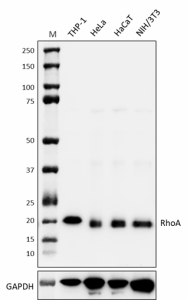- Clone
- A18230D (See other available formats)
- Regulatory Status
- RUO
- Other Names
- Ras Homolog Family Member A, Transforming protein RhoA, Ras Homolog Gene Family, Member A, Aplysia Ras-Related Homolog 12, RHOH12, ARH12, ARHA, RHO12, Epididymis Secretory Sperm Binding Protein
- Isotype
- Mouse IgG1, κ
- Ave. Rating
- Submit a Review
- Product Citations
- publications

-

Whole cell extracts (15 µg total protein) from indicated cell lines were resolved by 4-12% Bis-Tris gel electrophoresis, transferred to a PVDF membrane, and probed with 0.5 µg/mL of Purified anti-RhoA (clone A18230D) overnight at 4°C. Proteins were visualized by chemiluminescence detection using HRP Goat anti-mouse IgG (Cat. No. 405306) at a 1:3000 dilution. Direct-Blot™ HRP anti-GAPDH (Cat. No. 607904) was used as a loading control at a 1:50000 dilution. Western-Ready™ ECL Substrate Premium Kit (Cat. No. 426319) was used as a detection agent. Lane M: Molecular weight marker -

HeLa cells were fixed with Fixation Buffer (Cat. No. 420801) and permeabilized with ice-cold methanol for 10 minutes, and blocked with 5% FBS for 1 hour at room temperature. Cells were then stained with 5 µg/mL of Purified anti-RhoA (clone A18230D), followed by incubation with 2.5 µg/mL of Alexa Fluor® 647 Goat anti-mouse IgG (Cat. No. 405322) (panel A) for 1 hour at room temperature. Nuclei were counterstained with DAPI (Cat. No. 422801) (panel B). Images were merged (panel C). The images were captured by a Revvity Operetta CLS™ High Content Analysis System with a 63X objective. Scale bar: 50 µm
| Cat # | Size | Price | Quantity Check Availability | Save | ||
|---|---|---|---|---|---|---|
| 635851 | 25 µg | 136€ | ||||
| 635852 | 100 µg | 324€ | ||||
RhoA, also known as Transforming protein RhoA, is a small GTPase that plays a crucial role in various cellular functions, such as cytoskeletal dynamics, cell migration, cell cycle regulation, and cellular development. It alternates between active and inactive states by binding to either GTP or GDP, respectively. It is primarily associated with the regulation of the cytoskeleton, particularly in the formation of actin stress fibers and actomyosin contractility. RhoA influences cell shape, polarity, and locomotion through its effects on actin organization. In human mesenchymal stem cells, RhoA activity switches the differentiation between adipogenesis or osteogenesis under actin-myosin-generated cytoskeletal tension via effector, Rho-kinases (ROCK). RhoA is essential for cleavage furrow formation and apical junctions in keratinocyte cell-cell adhesion. In the developing nervous system, p75NTR induces RhoA strengthening on actin assembly which limits growth cone mobility and neuronal elongation. RhoA is found overexpressed or hyperactivate in many types of cancers, including prostate cancer, gastric cancer, testis cancer, breast cancer, and chronic myeloid leukemia. A RhoA inhibitor targeting RhoA/Rho GTPase pathway aims to prevent breast cancer cell growth as a potential cancer drug.
Product DetailsProduct Details
- Verified Reactivity
- Human, Mouse
- Antibody Type
- Monoclonal
- Host Species
- Mouse
- Immunogen
- Recombinant fragment of human RhoA
- Formulation
- Phosphate-buffered solution, pH 7.2, containing 0.09% sodium azide
- Preparation
- The antibody was purified by affinity chromatography.
- Concentration
- 0.5 mg/mL
- Storage & Handling
- The antibody solution should be stored undiluted between 2°C and 8°C.
- Application
-
WB - Quality tested
ICC - Verified - Recommended Usage
-
Each lot of this antibody is quality control tested by western blotting. For western blotting, the suggested use of this reagent is 0.5 - 1.0 µg/mL. For immunocytochemistry, a concentration range of 1.0 - 10.0 μg/mL is recommended. It is recommended that the reagent be titrated for optimal performance for each application.
- Application Notes
-
For use of this antibody (clone A18230D) in immunocytochemistry (ICC), it is recommended to fix cells with Fixation Buffer (Cat. No. 420801) followed by permeabilization with ice-cold methanol or fixation and permeabilization with ice-cold methanol only.
This antibody is not recommended for immunohistochemistry on formalin-fixed paraffin-embedded tissues (IHC-P). - RRID
-
AB_3106120 (BioLegend Cat. No. 635851)
AB_3106120 (BioLegend Cat. No. 635852)
Antigen Details
- Structure
- Contains two switch regions, Switch I and Switch II, modified by its activation status
- Distribution
-
Expressed widely in most tissues/Located primarily in cytoplasm, may detect at low expression levels in nucleus
- Function
- GTPase which regulates cytoskeleton organization/Regulated by guanine nucleotide exchange factors (GEFs)
- Interaction
- ROCK1, ROCK2, ARHGEF2, ARHGEF3, ARHGDIA, ARHGDIB, ARHGEF28
- Cell Type
- Neurons, Platelets
- Biology Area
- Apoptosis/Tumor Suppressors/Cell Death, Cardiovascular Biology, Cell Adhesion, Cell Motility/Cytoskeleton/Structure, Cell Structure, DNA Repair/Replication, Neuroscience, Synaptic Biology
- Molecular Family
- GTPases, Microtubules
- Antigen References
-
- Yamashita T, et al. 1999. Neuron. 24:585-93.
- McBeath R, et al. 2004. Dev Cell. 6:483-95.
- Pertz O, et al. 2006. Nature. 440:1069-72.
- Dubash AD, et al. 2011. PLoS One. 6:e17380.
- Shimokawa H, et al. 2016. Circ Res. 118:352-66.
- Tsubaki M, et al. 2021. Biomedicines. 9:35.
- Gene ID
- 387 View all products for this Gene ID
- UniProt
- View information about RhoA on UniProt.org
Related Pages & Pathways
Pages
Related FAQs
Other Formats
View All RhoA Reagents Request Custom Conjugation| Description | Clone | Applications |
|---|---|---|
| Purified anti-RhoA | A18230D | WB,ICC |
Compare Data Across All Formats
This data display is provided for general comparisons between formats.
Your actual data may vary due to variations in samples, target cells, instruments and their settings, staining conditions, and other factors.
If you need assistance with selecting the best format contact our expert technical support team.
 Login / Register
Login / Register 









Follow Us